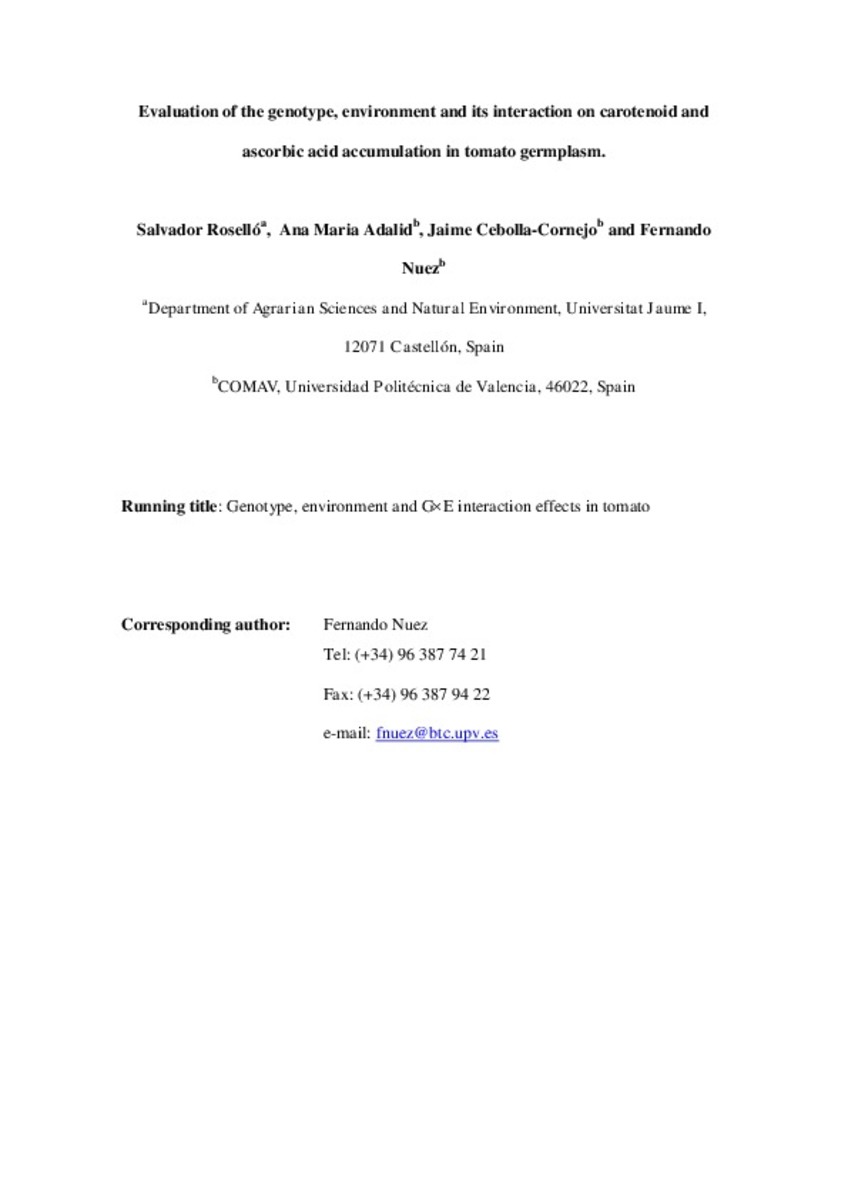Mostrar el registro sencillo del ítem
Evaluation of the genotype, environment and their interaction on carotenoid and ascorbic acid accumulation in tomato germplasm
| dc.contributor.author | Roselló, Salvador | |
| dc.contributor.author | Adalid, Ana María | |
| dc.contributor.author | Cebolla-Cornejo, Jaime | |
| dc.contributor.author | Nuez Viñals, Fernando | |
| dc.date.accessioned | 2012-05-31T08:28:27Z | |
| dc.date.available | 2012-05-31T08:28:27Z | |
| dc.date.issued | 2011-04 | |
| dc.identifier.citation | Journal of the science of food and agriculture (April 2011), vol. 91, no. 6, 1014–1021 | |
| dc.identifier.issn | 0022-5142 | |
| dc.identifier.issn | 1097-0010 | |
| dc.identifier.uri | http://hdl.handle.net/10234/39420 | |
| dc.description.abstract | BACKGROUND: Tomatoes are an important source of antioxidants (carotenoids, vitamin C, etc.) owing to their high level of consumption. There is great interest in developing cultivars with increased levels of lycopene, β-carotene or L-ascorbic acid. There is necessary to survey new sources of variation. In this study, the potential of improvement for each character in tomato breeding programmes, in a single or joint approach, and the nature of genotype (G), environment (E) and G × E interaction effects in the expression of these characters were investigated. RESULTS: The content of lycopene, β-carotene and ascorbic acid determined was very high in some phenotypes (up to 281, 35 and 346 mg kg−1 respectively). The important differences in the three environments studied (with some stressing conditions in several situations) had a remarkable influence in the phenotypic expression of the functional characters evaluated. Nevertheless, the major contribution came from the genotypic effect along with a considerable G × E interaction. CONCLUSION: The joint accumulation of lycopene and β-carotene has a high genetic component. It is possible to select elite genotypes with high content of both carotenoids in tomato breeding programmes but multi-environment trials are recommended. The improvement of ascorbic acid content is more difficult because the interference of uncontrolled factors mask the real genetic potential. Among the accessions evaluated, there are four accessions with an amazing genetic potential for functional properties that can be used as donor parents in tomato breeding programmes or for direct consumption in quality markets | ca_CA |
| dc.format.extent | 25 p. | ca_CA |
| dc.format.mimetype | application/pdf | ca_CA |
| dc.language.iso | eng | |
| dc.publisher | Wiley-Blackwell | |
| dc.relation.isFormatOf | Versió pre-print del document publicat a: http://onlinelibrary.wiley.com/doi/10.1002/jsfa.4276/abstract | ca_CA |
| dc.rights | Copyright © 2011 Society of Chemical Industry | ca_CA |
| dc.rights.uri | http://rightsstatements.org/vocab/InC/1.0/ | * |
| dc.subject | Solanum section Lycopersicon | ca_CA |
| dc.subject | Genetic resources | ca_CA |
| dc.subject | Functional quality | ca_CA |
| dc.subject | Lycopene | ca_CA |
| dc.subject | β-carotene | ca_CA |
| dc.subject | Vitamin C | ca_CA |
| dc.subject | Linear mixed models | ca_CA |
| dc.subject.lcsh | Tomatoes--Genetics | ca_CA |
| dc.subject.other | Tomàquets--Genètica | ca_CA |
| dc.title | Evaluation of the genotype, environment and their interaction on carotenoid and ascorbic acid accumulation in tomato germplasm | |
| dc.title.alternative | Evaluation of the genotype, environment and its interaction on carotenoid and ascorbic acid accumulation in tomato germplasm | |
| dc.type | info:eu-repo/semantics/article | |
| dc.identifier.doi | http://dx.doi.org/10.1002/jsfa.4276 | |
| dc.rights.accessRights | info:eu-repo/semantics/openAccess | ca_CA |
Ficheros en el ítem
Este ítem aparece en la(s) siguiente(s) colección(ones)
-
CAMN_Articles [566]







